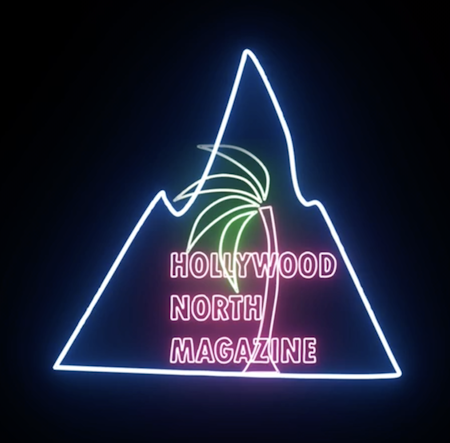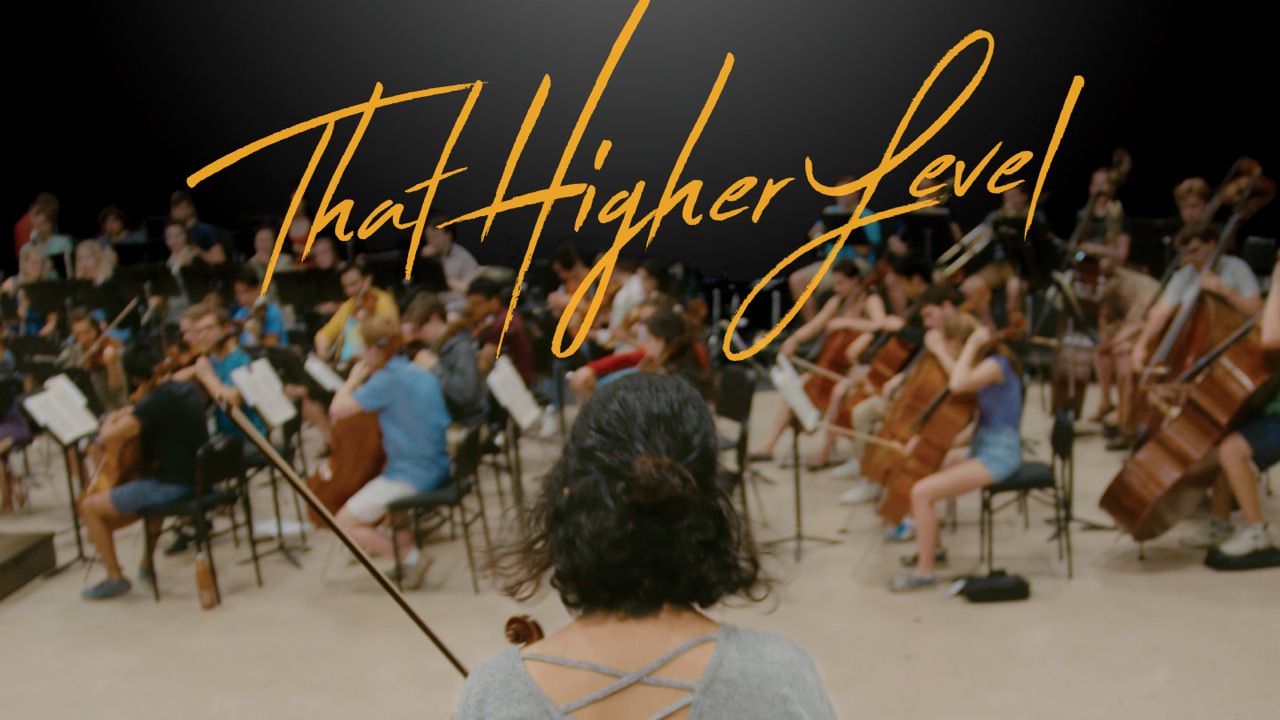What is music to your ears? For some it might be rockn’roll and others country music. There’s rap-music, pop music, heavy metal, blues, jazz, polka and disco! Am I forgetting anyone? Oh yes… classical. It might not be as popular as the others but it has been around longer than them all combined. That does speak volumes and deserves to be heard. Classical music has cemented itself into our culture and is universally listened to across the globe. It unites us unlike anything else. It is pure and raw with anger and loss, with rebirth and death, with celebration and duty. You cannot find the range of emotion in any other one genre.
In the documentary film That Higher Level, even if you are not familiar with classical music, after watching it you will have your eyes and ears wide open along with a tremendous respect and admiration for the musicians that play it. Before I watched this film I had only scratched the surface on my experience with classical music. John Bolton takes you on a journey that slowly immerses you into a bubbly hot tub of sounds you will only here from some of the best classically trained musicians our country has to offer. The film really feels like a warm embrace that holds onto you until your every pore is filled with every sweet sound the orchestra can squeeze from its garden. It is pure magic and John Bolton is the ringmaster.
We caught up with John at the National Film Board in Vancouver. I wanted to know where it all began and he was gracious enough to share his journey with us.
“Have you always been a documentary filmmaker?”
“Lately I’ve been focusing on documentaries but I’ve also made comedic short films, dramatic short films, I’ve adapted several short stories by several authors and I’ve done a lot of musical films. I like to call them classical music videos, so I’ve done many films about and with musicians and classical musicians in particular.”
“Have those been feature films?”
“No, many of them have been short films up until the last two, which are both features. That Higher Level and another that I made a few years ago called Aim For the Roses. I call it a musical docudrama because it had musical aspects, it had documentary aspects and it had dramatic recreations and everything in between. It was more of a mash up but this one is more of a conventional musical documentary, however I’m still drawing on all kinds of musical filmmaking and work that I’ve done with musicians and classical musicians.”
“What is the draw to keep creating music based films?”
“I’ve always loved music and I was lucky enough when I was younger that there was a music program in my elementary school and high school. Through the Vancouver School Boards Strings Program I was able to play the viola as well as play in smaller orchestras and then larger ones. I started taking private lessons and later played in the Vancouver Youth Symphony Orchestra while I was in high school. I did however realize that I enjoyed listening to music more than I enjoyed playing it. My girlfriend and I were both in the VYSO back in high school. We started around the same level but she always practiced more than me and she ended up majoring in music and university and doing her masters. Now she’s a professional musician. There was this turning point where she started practicing more and began to excel much faster. I continued to go to the symphony all the time as well as the concerts but playing was really my introduction to listening. Since I was also very much interested in filmmaking, one of first professional films for Bravo television was about a string quartet performing Beethoven Opus 59 No. 3 Allegro Molto. It was a movement of music that the Borealis String Quartet was playing. They were the quartet residence at the UBC and I did a little film featuring them performing at the Chan Centre. I had it all figured out how I wanted to do it and we shot for 4 hours with 4 cameras. I like to think that I’ve made more of a contribution to classical music as a filmmaker than I would have as a musician.
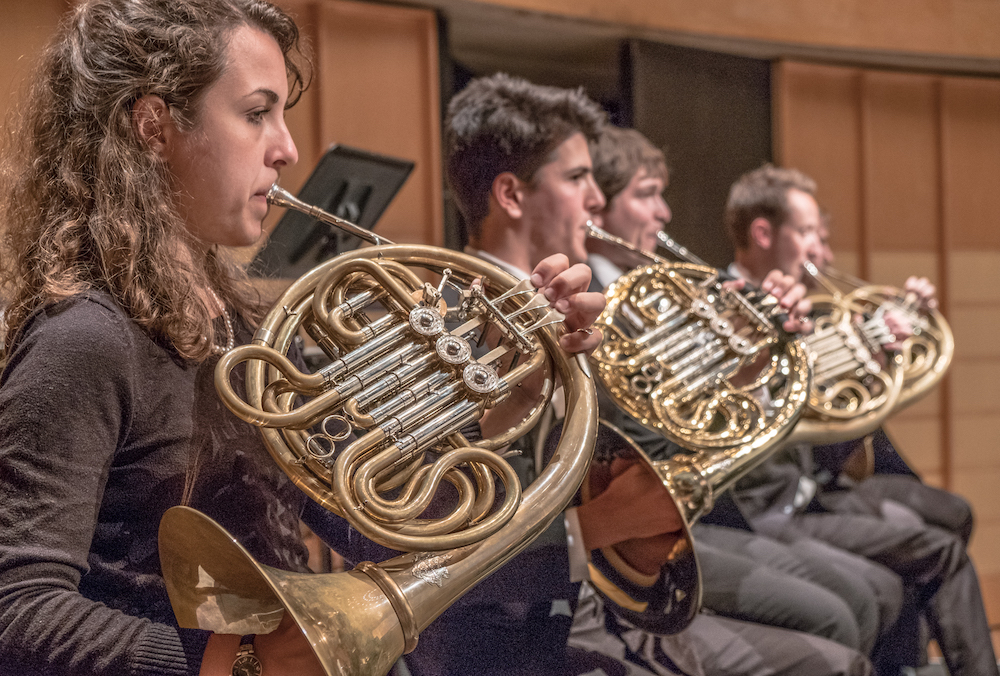
French horn section in rehearsal. Photo courtesy of Jeff Topham
“How did you come up with the title, That Higher Level?”
“It’s actually one of the things a student says in the film. When making music, you want to get past thinking about your technique, thinking about how you’re playing and trying to be in the moment. You’re getting to a point where your technique is in the service of an idea or an interpretation. It’s like being in the moment or getting in the zone and that really resonated with me that they’re all aspiring to take their art and their lives to that next level, that higher level.”
“Having chosen one individual to represent each section of the orchestra, did you feel like you got to know each of them on a more personal level?”
“Definitely, I had spent two months with them and was fully embedded. I initially spent one month with them at the training institute in Waterloo and another month on tour with them going across Canada. The NYO (National Youth Orchestra) gave me unlimited access. From the very first week I was sitting in on their little chamber music festival where they all play in chamber music ensembles and I got to sit in on the rehearsals.”
“What would that have consisted of?”
“They’d put them into string quartets, wind ensembles or percussion ensembles. They focus on chamber music first before they start focusing on the orchestral repertoire. Not to be confused with sectional music, which is when all the string section will get together or the brass or viola section. Chamber music is music without a conductor. That means the NYO handpicks 2 violinists, a violist and a cellist and tells them they’re going to play this Beethoven quartet. That would be something they’d focus on separately from the orchestral repertoire that they’re learning. For the first week I was there on my own and getting to know them. They have 3 meals per day so I’d try to sit with a different group every day. By the time my film crew showed up I had won their trust, they knew me and it was pretty easy to start incorporating the filming.”
“Did you know how you wanted to shoot it or was that established in that first week of getting familiar with the musicians?”
“I knew that I wanted to focus on at least one musician from each section of the orchestra. I also knew that I wanted to focus on just one piece of music in particular. When there are 100 students playing a dozen pieces of music you have to narrow your focus. That first week was very useful because it showed me that Richard Strauss’s piece Death and Transfiguration was the piece that they were most excited about playing. It’s also the most challenging piece of music; the most emotional piece of music and it’s a piece of program music, which means that it tells a story. From there we had to come up with a shooting schedule where we’d make sure we were shooting this section or that rehearsal. Before I went out I’d seen all of the students audition tapes and had asked them all to shoot a little video of them answering just a few questions. By doing that I felt like I’d met them all before and had made every effort to learn all of their names. After that, it was like casting. I had to decide whom I’d focus on from the violin section, the horn section and whom I’d focus on from the percussion section? I wanted a variety of diverse characters of musicians and kids. We ended up settling on 14 characters, which is a lot of characters for a documentary. The challenge is, when you have 14 characters you can’t follow them all at the same time. When we got to the editing we figured it would make the most sense to focus on them one at a time. We decided to introduce them in the order that their instruments are featured in this piece. The piece starts with the violas and second violins, so lets start with the violas. There’s a famous figure on the timpani so then we meet one of the percussionists. There’s a lovely figure on the flute so then we meet our flute player and on and on. As we’re getting to know these characters we’re also getting to know this piece of music. By the end, when they perform it you watch these characters and the music come together. That was the idea behind the structure.”
“When the students representing each section talk about the reason they chose their instrument, were those stories discussed/determined before shooting?”
“In the case of Jon (double bass), who everyone called Mac, I had asked Barbara at NYO if she knew anyone that would make for an interesting character. Jon was one of the first people she thought of because he’s not what you’d expect. I think what made Jon interesting is that he had made it all the way to university playing double bass and football. He had to sacrifice something he loved. Later in the film, he deals with an injury when we happened to be filming him in rehearsal. With the orchestra playing the climax of the Strauss piece his arm suddenly seizes up and he drops his bow. He couldn’t move his hand and it’s happened to him before. He became worried he’d be sent home and then worried about his future and entire career. I like that he’s an athlete because musicians really are athletes given all the training they go through. An injury can end the career of a musician the same way an injury can end an athlete’s career. In music we focus more on the mental aspect and forget how physical it is, especially with the double bass; that is a big instrument to carry around.”
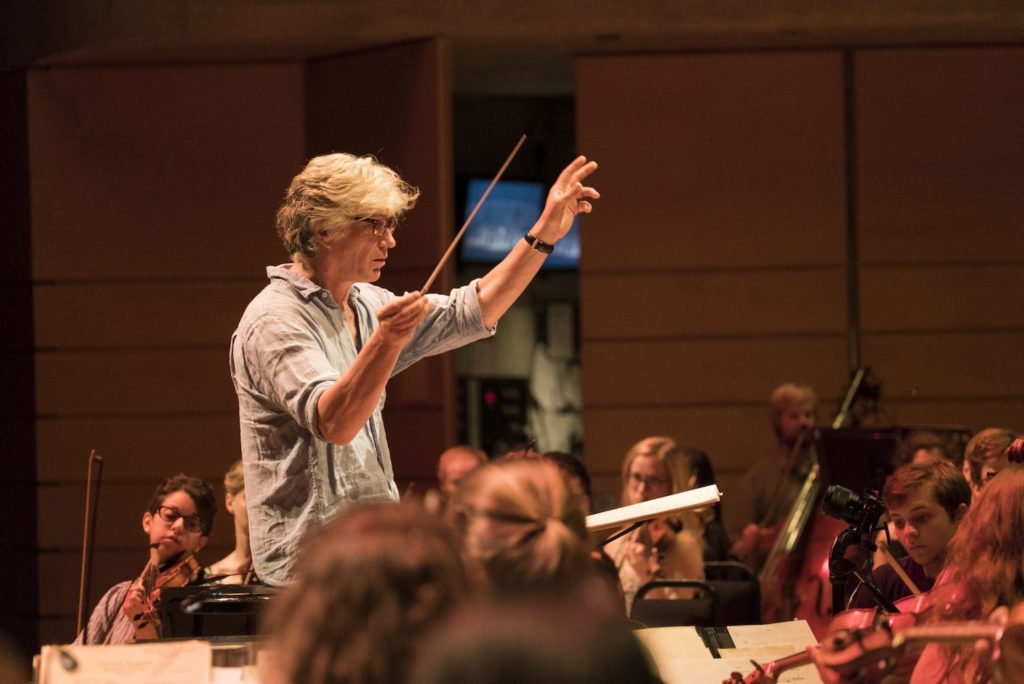
“One of the things I found most fascinating in the film was when the student seemed to be playing so impressively and flawless up until the instructor/master shows them how to enhance the piece and bring it to that other level. There was quite a contrast.”
“We got to shoot one of the master classes with Cho-Liang Lin, who is one of the worlds greatest violinists. One of my favourite moments is when they’re practicing a particular part of Strauss and I thought they sounded pretty good and then the teacher says ‘pretty good for a first read, now lets get to work.’ They’re called master classes for good reason. You want to get to a point where you can play the notes but being able to play them doesn’t matter as much as the intention and how you’re playing them. That goes to matters of phrasing, expression and colour. It’s not so much about hitting the notes, that’s just a bare minimum at this level. Throughout the course of the film I hope you see how far they’ve come from trying to learn how to play this piece to really performing it, which is a journey. Strauss’s Death and Transfiguration is about an artist on his deathbed looking back on his life and fighting death but eventually dying. The analogy for me is, for an orchestra to play a piece like that is comparable to a theatre company taking on a great Shakespeare play. This is a piece that’s filled with huge ideas and huge emotions and if you’re going to play it you’ve got to grapple with all of those, just like an actor has to interpret those words and get into character. It’s really emotionally exhausting for them, which is another reason I’m happy we focused on that piece.”
“I’m not that familiar with classical music. Are most pieces telling a story?”
“Death and Transfiguration is what’s called a tone poem. It’s basically a piece of program music; by program music that means it does tell a story through music. It has a beginning, middle and an end. We also know from the composer’s notes or what they’ve said about it, it’s even in the score of the piece. We’re aware in the beginning that he’s on his deathbed and his heart is failing, then there’s this struggle against death. He looks back on his life in the military, so then there’s this military theme, there’s a love theme and then he struggles with death again until he passes away and rises up. That’s the final transfiguration. Not all pieces tell a literal story but you’re still going on an emotional journey and another reason why it felt like a good fit for this film.”
“What is the biggest message in this film?”
“I hope that it’s educational and that the people watching this film will feel inspired by these kids dedicating themselves to something bigger than themselves and the many sacrifices they make. It has to be said that for most of these kids, the best-case scenario will be barely making a living as a classical musician. None of them are in it for the money and are really in it for the love of it. Most will want to play in orchestras and that means playing pieces written by someone else. There’s something really selfless about that and I find that really beautiful. If you love classical music you’re going to get something out of this because we had unbelievable access that’s very hard to get. To be able to spend 2 months with 100 musicians as they come together as an orchestra was just amazing. I also hope that people who don’t know a lot about classical music will have a much better idea, an understanding and an appreciation of what it takes. Like all my films about musicians and artists, I want to demystify it while also honouring it.”
“How long did pre production take?”
“This film came together really quickly. We jumped right into pre production in the early spring and jumped into production in the summer, followed by post-production and finishing it in the new year. It took less than a year to go from start to finish.”
“After the tour the band breaks up. Did you ask them how they felt about that?”
“The reality is, that the morning after the final concert they’re flying back to school, to home or they’ve got auditions or other concerts. It all ends suddenly. We have footage of them hugging and crying but we didn’t have anymore time to interview them afterward. There were a few that I’d asked about they’re expectations or their anticipations but I really wanted to go out on a high note. When the film was finished I had met up with some of the students. They’d told me it felt like such a long time ago and that so much has changed since then, but for me it felt like I never left. After shooting you’re spending time with 100 hours of footage. For all of them that have seen it they say it’s brought back a lot of memories and that it’s really emotional. When you make a film about someone or an orchestra, you’re more or less conferring immortality. In this way, that edition of NYO Canada will live forever and they can go out on a high note.”
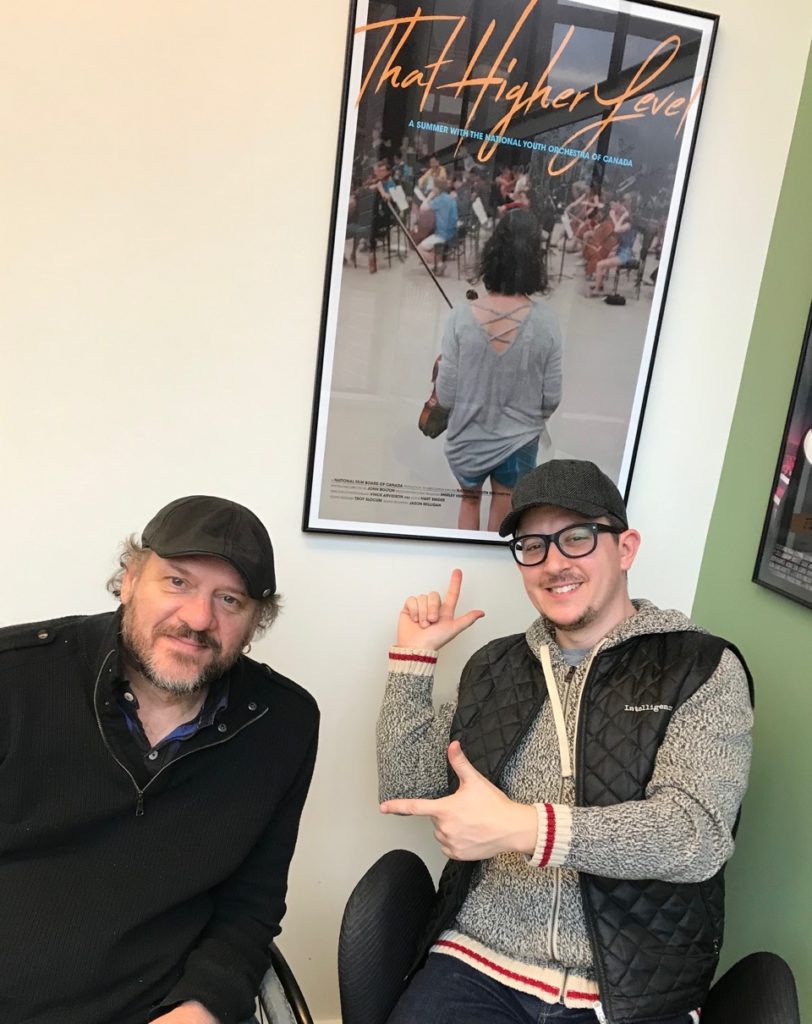
John follows up with telling me about the vast diversity within the group and where to find them.
“All of the students have come from across Canada and some of the youngest performers are still in high school. Most are in the middle of doing their undergraduate degrees or masters, either in Canada or in the US. To be in NYO Canada you need to be Canadian and between the ages of 14-28. Every year the tour is different and one of the reasons we decided to make the film in 2017 was for Canada 150. It was their most ambitious tour ever, which was a 12-city tour across Canada. Last year they went to Europe and sometimes they just do Western or Eastern Canada. Every year the tour is different but the training institute is the same.”
This was an amazing documentary to watch. It gave me a new appreciation for classical music and the dedication that it takes to play in a symphony orchestra. John Bolton has created something unique and mesmerizing with a splash of genius.
The film will have its world premiere on February 9th at the Victoria Film Festival in Victoria, BC on Sat, Feb. 5th at 6:15 at the Vic.
Here’s the link: Sat | February 9 | 6:15 PM | The Vic
https://issuu.com/vff_comm/docs/2019-vff-programguide-online?e=2282713/66796597
